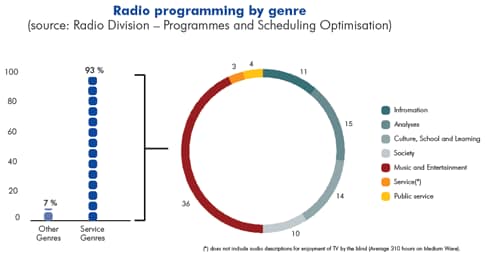|
|||||||||||||||||||||||||||
Rai Radio
Never more than in the year that has just
ended have the new Radio applications
become the flipside of an ancient and
very valuable coin, which maintains and
increases its traditional value in the
digital age.
People listen to the radio anyway and
everywhere, using any kind of
technology: analogue, digital, web and
satellite. With every instrument:
transistor, stereo, car-radio, internet,
mp3 player, smartphone, satellite and
digital television or social network. For
any reason and with any expectation,
or maybe without any expectation at
all. Simply because it exists, there's
plenty of it and it's free. Because it
works in symbiosis with the Network
and with its style.
In 2011 Digital Terrestrial Radio has
become operational, with the
progressive availability of frequencies,
with the experimentation of standards
also accepted by private radio stations,
and with the initiative of the producers of
receivers and big car manufacturers,
decisive for technological, industrial and
social regeneration.
RadioRai is called upon to fulfil its digital
destiny in a dynamic, pluralist market,
which offers extensive growth potential,
also at commercial level: the advanced
audio products market.
This explains the considerable
development of innovative services
aimed at generating new flows of
consumption, new listener profiles and
new opportunities to generate income.
Podcasting. This is the first and most
fortunate example of RadioRai's nonlinear
offering. In 2010, it totalled 21
million downloads (+56% on 2009),
broken down as follows: 48% Radio2,
42% Radio3, 10% Radio1, reflecting the
different broadcasting profiles. The
growing appeal to a demanding and
expert audience has favoured innovative
choices: exclusive products, hybrid
formats, language experiments and the
first revenues from advertising (a total of
14 weeks of specially created advertising
campaigns).
Streaming. Live listening via Internet,
conditioned by the connection methods,
is catalysed by big events. Radio1
touched the annual peak in June, with
1.5 million visits during the South
African World Cup, Radio2 exceeded
1.2 million contacts during the specials
of Caterpillar – M'illumino di meno
(March), while Radio3 maintains a
monthly level of 150,000 accesses.
Tutta Radio in tasca. The
smartphone application launched in
May develops an average of 4,300
single users a day. Overall, it was
downloaded by almost 160,000 users
during the first eight months of service,
with listening sessions with an average
duration of more than 9 minutes.
Web Radio. The three new audio
channels which draw on the endless
RadioRai audio deposits were launched
in November. A fourth channel
dedicated to Neapolitan music and song
is being planned.
WR6 The past present. Dedicated entirely
to the rediscovery of the documents of
RadioRai's digital audio library.
WR7 Music and musicians. Rare
performances by masters, selected from
almost 100 years of repertory kept in Via
Asiago.
WR8 The world of the web. It reverses
the traditional relationship between
broadcaster and listener, opening up to
the taste and style of user generated
content.
Radio is very good at adapting to
changing technology and consumption,
but digital forerunners continue to prefer
Radio on air. The effort to make Radio
productions is a necessity which is far
from obsolete. It continues to be the
main mission assigned to RadioRai.
Programming in 2010 accentuated
broadcasting and communication
synergies with big TV events, making the
different broadcasting profiles more
recognisable, reducing fragmentation
and strengthening interactions with the
web. The editions of the Giornale Radio
were redesigned, with exclusive Channel
formats, diversification of themes by
target, elimination of overlaps or
photocopy editions.
The measuring of listeners was stopped
following the decision by Audiradio to
suspend the Diari panel research, which
assigned the medium and the big radio
stations flattering results which weren't
actually truthful. Consequently, 2011 is
expected to bring the indispensable
recovery of an advanced research,
capable of portraying the physiognomy
and value of the Radio.
The Cati research continued to supply
figure obtained from telephone
interviews, relating to all local private
broadcasters and a few national noncommercial
stations, including Isoradio,
which reports a stable performance
compared to 2009 for the average day
(1.0 million listeners) and a slight
increase over the 7 days (4.2 million).

A map of RadioRai
Radio1
Information: GR1 (25 editions a day) Hallo, Italia!
Analysis: Radio anch'io, Tutto il calcio minuto per minuto, Zapping, Zona Cesarini, Ventura football club
Culture, School and Learning: Con parole mie
Work, Society, Social Communication: Italia-Istruzioni per l'uso, La radio ne parla
Music and Entertainment: Festival di Sanremo, Start, Tornando a casa, Demo, Invito personale
Service: Oggi duemila
Variety: Ho perso il trend, Attenti a Pupo, Benfatto, Il comunicattivo
Radio2
Society, Work, Social Communication: Ventotto minuti, Un giorno da pecora
Music and Entertainment: Caterpillar, Il ruggito del coniglio, Hit Parade, Decanter
Variety: Io Chiara e l'oscuro, 610 - Sei Uno Zero, Traffic, Ottovolante, Black Out, Nostree, Taxi driver,Radio2 days
Sport: Circo Massimo
Radio3
Analysis: Prima pagina, Radio3 Mondo, Pagina 3, Tutta la cittŕ ne parla, Chiodo fisso
Culture, School and Learning: Fahrenheit, Hollywood party, Ad alta voce, Radio3 Scienza, Zazŕ,
Music and Entertainment: I Concerti del Quirinale, Momus, Passioni, Radio3 Suite, Sei gradi
Service: Uomini e profeti
Variety: Dottor Djembč, La Barcaccia